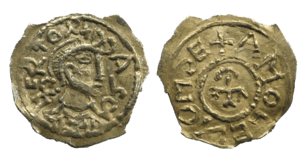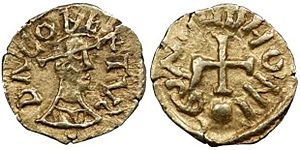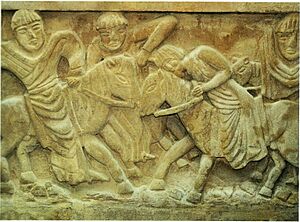Dagobert II facts for kids
Quick facts for kids Dagobert II |
|
|---|---|
| King of Austrasia | |

A gold tremissis of Dagobert II
|
|
| Reign | 675/6–679 |
| Predecessor | Clovis III |
| Successor | Theuderic III |
| Died | 679 |
| Father | Sigebert III |
| Mother | Chimnechild |
| Venerated in | Catholic Church |
| Canonized | Pre-congregation |
| Feast | 23 December |
| Attributes | King with a nail in his hand |
Dagobert II (died 679) was a Merovingian king who ruled Austrasia, a part of the Frankish kingdom, from 675 or 676 until his death. He is not as well-known as some other Merovingian kings. Since the 800s, many people have considered him a martyr, someone who died for their beliefs.
We don't have many detailed stories about Dagobert's time as king. Historians have pieced together his story from different old records. When his father died in 656, Dagobert was sent away to Ireland to live as a monk. Later, Wilfrid, a bishop from England, helped him return to Austrasia. He became king after his cousin was killed in 675. During his short rule, he fought against the nearby kingdom of Neustria. He also made a peace agreement with the Lombard Kingdom in Italy and started making gold coins again.
Some old writings describe Dagobert as a strict ruler. He had disagreements with church leaders and introduced new taxes. He was killed by a group of powerful nobles. After his death, his cousin, Theuderic III, who was king of Neustria, took over Austrasia.
Contents
Early Life and Exile
Dagobert was the son of Sigebert III, who was king from 632 to 656. His mother's name is not fully known. He was named after his grandfather, Dagobert I.
According to an old book called The Book of the History of the Franks, after King Sigebert died, a powerful official named Grimoald the Elder, who was the "mayor of the palace," took control. Grimoald arranged for Dagobert to have his hair cut short, a process called tonsure. This made Dagobert unable to become king, because Merovingian kings always wore their hair long. Dagobert was then sent to Ireland. These events likely happened around 656.
We don't have many details about Dagobert's time in Ireland. Some historians believe he lived in a monastery in a place called Slane.
Grimoald tried to make his own son, Childebert the Adopted, king of Austrasia. But the Neustrians, led by Clovis II, arrested Grimoald and had him executed. They said he had acted against the rightful king. In 662, Clovis II's son, Childeric II, became king of Austrasia. Childeric was married to Dagobert's half-sister, Bilichild. Childeric was killed in 675.
Childeric's death led to a civil war and created a chance for Dagobert to return. The former mayor of the palace, Ebroin, tried to make another king, Clovis III, rule Austrasia. But then Dagobert was called back from Ireland.
Return to Austrasia
While The Book of the History of the Franks tells us about Dagobert's exile, another book, Life of Wilfrid, describes his return. This book was written in the early 700s about an English bishop named Wilfrid. It says that Dagobert was sent to Ireland when he was young. Later, his friends and family found out he was still alive. They asked Bishop Wilfrid to help bring him to England and then send him back to Austrasia.
The Life of Wilfrid doesn't say exactly who asked for Dagobert's return, only that it was his "friends" and "relatives." Some historians think it might have been powerful leaders like Wulfoald or Pippin of Herstal.
We don't know the exact date Dagobert became king. Childeric II was killed in 675, and Dagobert was definitely on the throne by July 676.
Dagobert's Reign
Not much is written about Dagobert's time as king. The Book of the History of the Franks doesn't mention him again after his exile. This might be because the author didn't see him as a true king. Perhaps it was because he had been away for so long, or because of the circumstances of his birth.
One old writing from the 600s, the Life of Abbess Sadalberga of Laon, briefly mentions Dagobert's reign. It says that a nun moved her convent because of "recent fighting between Kings Dagobert and Theuderic." This is the only mention of a war between Dagobert and his cousin, Theuderic III of Neustria. This war shows the ongoing conflict between the Austrasians and Ebroin, the powerful Neustrian mayor of the palace.
The war likely took place in Burgundy, which was under Neustrian rule. This suggests that Dagobert's forces were strong at the time. It might have been during this war that Pippin of Herstal and Martin of Laon attacked Theuderic III. This attack was defeated by Ebroin at the Battle of Lucofao, where Martin died. This battle might have happened in September 679, when Dagobert was still alive.
In 676, Dagobert signed a "very strong peace agreement" with the Lombards. We know this date because the source, the History of the Lombards, also mentions a comet appearing in August of that year. The Lombard king at the time was Perctarit.
The only official document from Dagobert that still exists confirms the lands owned by the monastery of Stavelot-Malmedy. In this document, Dagobert mentions gifts made by his father. He does not mention that Grimoald, the man who exiled him, founded the monastery.
Dagobert also restarted the making of gold coins, which had stopped around 670. His gold coins, called tremissis, had a new style. They copied the cross on three steps seen on Byzantine coins. Dagobert was also the last king to have coins made in his name in Marseille.
In 679, Bishop Wilfrid visited Dagobert's court. Wilfrid was on his way to Rome for a church meeting. Dagobert was thankful to Wilfrid for helping him return from Ireland. Dagobert offered Wilfrid an important church position in Strasbourg, but Wilfrid said no. Dagobert gave him weapons and companions for his journey to Rome.
Later in 679, shortly after Wilfrid's visit, Dagobert was killed. The Life of Wilfrid says that "treacherous dukes" planned his death with the approval of some bishops. A later story says he was killed by his own godson, John, while hunting. The traditional date of his death, December 23, is widely accepted.
After Dagobert's death, Ebroin managed to bring Austrasia under Theuderic III's control. When Wilfrid returned through Austrasia in 680, Ebroin's men arrested him. They blamed him for arranging Dagobert's return. The Life of Wilfrid describes Dagobert as someone who "destroyed cities, ignored the advice of important people, and burdened the people with taxes." It also says he was "disrespectful of God's churches and their bishops."
Saint and Martyr
The Life of Wilfrid is the only source that tells us about Dagobert's assassination. However, we know he was honored as a martyr in the Ardennes region by the late 800s.
There are different ideas about where Dagobert was buried. One early 700s book says he was buried in the church of Saint Peter in Rouen. This was next to his predecessor, Childeric II.
Another book, Life of Dagobert, written in the 890s, says Dagobert was buried at Stenay. This makes sense because Stenay was in the center of Austrasia. However, this book sometimes confuses Dagobert II with another king, Dagobert III.
In 872, Charles the Bald, a king of West Francia, helped bring Dagobert's cult (his honoring as a saint) back to life. He had Dagobert's remains moved to a special church built in Stenay. This timing suggests Charles was trying to strengthen his power in that area.
Dagobert's feast day, or special day of remembrance, was December 23. This date is found in several old church calendars. However, his festival was not widely celebrated outside of Stenay. The church dedicated to him in Stenay was closed in 1580. In 1591, the buildings were attacked, and Dagobert's remains were scattered.
See also
 In Spanish: Dagoberto II para niños
In Spanish: Dagoberto II para niños
Images for kids






